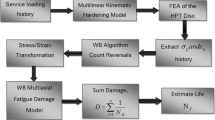Abstract
Gas welding is a very important and useful technology in the fabrication of railroad cars and commercial vehicle structures. However, since the fatigue strength of gas-welded joints is considerably lower than that of the base of material due to stress concentration at the weld, the fatigue strength assessment of gas-welded joints is very important for the reliability and durability of railroad cars and establishment of criteria for long-life fatigue design. In this study, after evaluating the fatigue strength using a simulated specimen that satisfies not only the structural characteristics but also the mechanical condition of the actual structure, the fatigue design criteria are determined and applied to the fatigue design of the gas welded body structure. To save time and cost for the fatigue design, we investigated an accelerated life-prediction using a probabilistic statistics technique based on the theory of statistical reliability. The (Δσ a )R-Nf relationship was obtained from actual fatigue test data, including welding residual stress. On the basis of these results, the (Δσa)R-(Nf)ALP relationship that was derived from statistical probability analysis was compared with the actual fatigue test data. Therefore, it is expected that the accelerated life prediction will provide a useful method of determining the criteria for fatigue design and predicting a specific target life.
Similar content being viewed by others
References
D. H. Bae and J. B. Huh, Key Eng. Mater. 2883 (2005).
I. S. Sohn and D. H. Bae, JMST Int. J. 15, 44 (2001).
W. S. Jung, D. H. Bae, and I. S. Shon, KSME Int. J. 18, 106 (2004).
D. W. Kim, C. H. Han, and B. S. Lee, J. Kor. Inst. Met. & Master. 47, 391 (2009).
JIS Z2273, Method of Fatigue Testing for Metallic Materials 7, 342 (1987).
JIS Z3103, Method of Repeated Tension Fatigue Testing for Fusion Welded Joints 7, 416 (1987).
W. Q. Meeker and A. Escobar, International Statistical Review, p. 147–168 (1993).
W. Nelson, Applied Life Data Analysis, p. 51–68, John Wiley & Sons, New York (1990).
R. R. Barton, IEEE T. Reliab. 40, 166 (1991).
Author information
Authors and Affiliations
Corresponding author
Rights and permissions
About this article
Cite this article
Baek, S.Y., Bae, D.H. A study on the fatigue life prediction of the various gas-welded joints using a probabilistic statistics technique. Met. Mater. Int. 17, 143–149 (2011). https://doi.org/10.1007/s12540-011-0220-2
Received:
Accepted:
Published:
Issue Date:
DOI: https://doi.org/10.1007/s12540-011-0220-2




